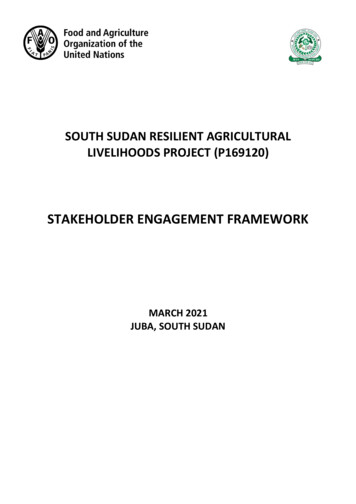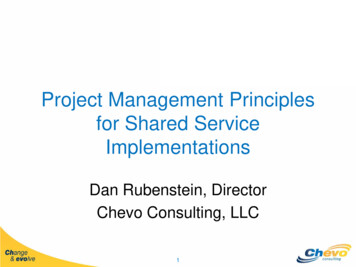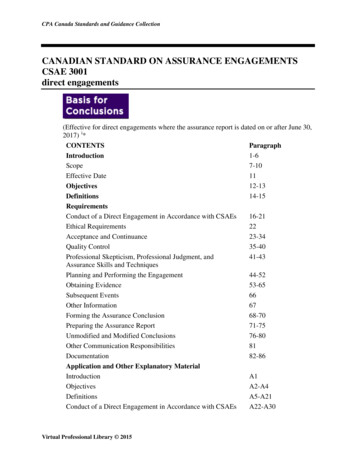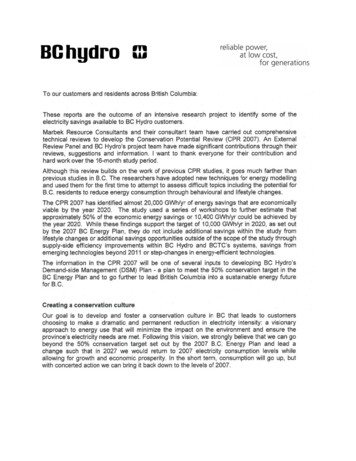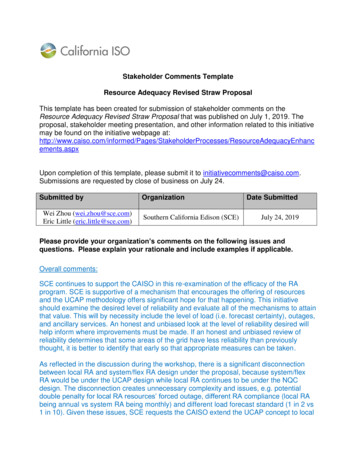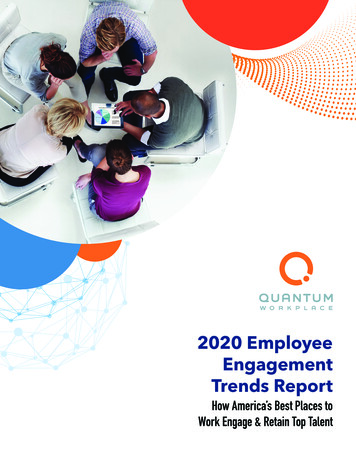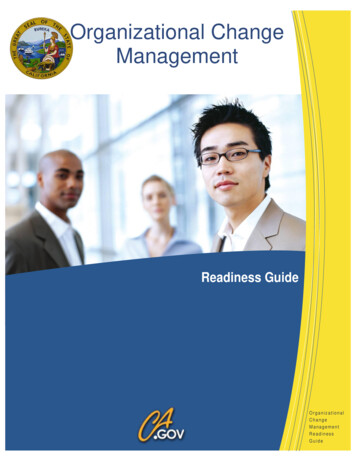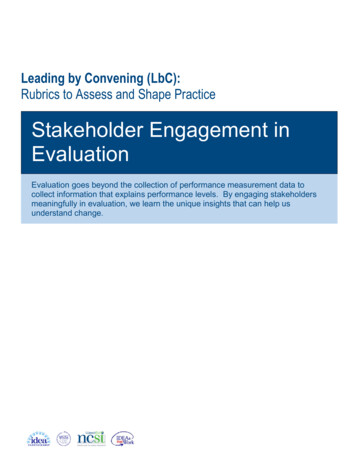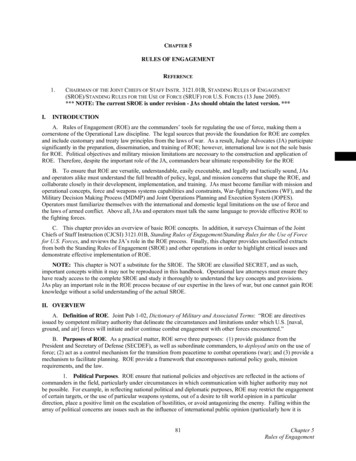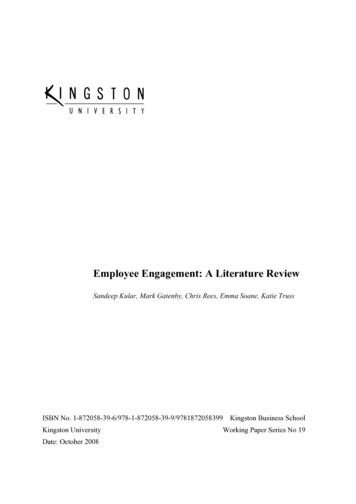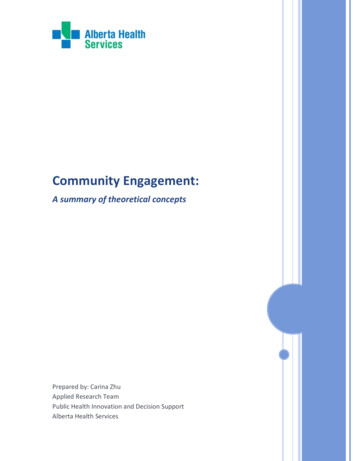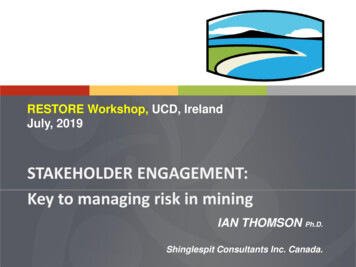
Transcription
RESTORE Workshop, UCD, IrelandJuly, 2019STAKEHOLDER ENGAGEMENT:Key to managing risk in miningIAN THOMSON Ph.D.Shinglespit Consultants Inc. Canada.
NOW RISK FACTOR #1Ernst & Young - 2019 Top Ten RisksDeloitte -2019 Tracking the Trends Underestimating the power ofeven a single stakeholderwould be a mistake.Deriving shared social outcomes is astrategic issueCompanies have long recognized theimperative of earning a social license tooperate.Social license to operate is becoming apivotal strategic issue that will eitherdifferentiate companies or derail them.
WHAT IS IT?
SOCIAL LICENSE – FIRST PRINCIPLESSocial License is: Granted by the localcommunity Intangible, informal, nonpermanent, dynamic Has to be earned and thenmaintained Defined as– Ongoing Acceptance orApproval An expression of the qualityof a relationship
EVOLUTION AS A MANAGEMENT TOOL Term coined by Jim Cooney. Placer Dome– Meeting at World Bank in March 1997 Current use of phrase in mining.Nelsen (2006):– SLO is granted by the community. renewable daily– Definition: Ongoing approval or acceptance Development of the concept as a management tool– Thomson & Joyce (2008): specified 3 levels– Thomson & Boutilier (2011): specified 4 levels & linked toresource dependence & stakeholder network analysis– Black (2013): measurement & factor analysis Usage spreading– Agriculture, infrastructure, energy, aquaculture, tourism
WHY HAS THE SLO BECOME SO IMPORTANT? Crowded World –– Always in some-ones ‘backyard’ Age of Communications –– Instant Access to (Dis)Information, Sharing, Organization Emergence of the ‘Risk Society’ (Beck, Gittins) – New Fears, New Risks Skepticism of ‘Experts’ and ‘Politicians’ Search for Credibility (Bricker & Greenspoon) –– Who to believe, who to TRUST (‘Trustmarks’) Rise of Stakeholder Power –– Decide, Organize and Act
WHAT IT IS NOT! Granted by government/authoritiesGiven in writingPermanentBased on a single task, transaction, test or eventAvailable for a ‘Fee’TransferableThe same in every case FPIC Sustainable Development
CONSEQUENCES OF NO SLO Lost access to landLost timeIncreased costsLoss of lifeLoss of projects/minesCompanies decimated/destroyedLaws changed/imposed
THERE ARE REAL COSTSEstimated asthe biggestin cost(up to manybillions)9Davis & Franks, 2014
SLO HAS MARKET VALUE Henisz, W. J., Dorobantu, S., & Nartey, (2014) Using publically available information for 26 gold mines from 19932002, demonstrated that having a SLO is worth up to 60% ofcorporate asset valuation : Spinning Gold: The Financial Returns toExternal Stakeholder Engagement. Strategic Management Journal(2014) Credit Suisse (2012)––Australian mining & hydrocarbon stocks valued 2.2% below fair value(AUS 8.4 billion loss) owing to ‘environmental, social & governancerisk’AGL Energy (Australia) lost 74% of its value when analysts discoveredstakeholder conflict
THE CONSEQUENCES OF CONFLICT AT ESQUELCommunity wanted dialog to be informed to feel listened-to evidence that company isresponsive to concerns A partnership in developmentSomething the company neverofferedReferendum YES 18% - NO 81% Meridian write down US 542.8 million Company weakened and stigmatized – subsequenttakeover by Yamana Province of Chubut passes laws banning open pitmining and use of cyanide in mineral processing
SLO IN INTERNATIONAL LAWBear Creek Mining v Republic of PeruClaim – US 522.0 millionAward – US 18.0 millionSouth American Silver v Plurinational State of BoliviaClaim – US 385.7 millionAward - US 18.0 million
RELATIONSHIP TO LEGAL AND POLITICAL LICENSE SLO fills governance gaps, caused by – Remote operations beyond ‘reach of the state’– Jurisdictional disputes, sub-national and international– Novel (unregulated) industries, technologies, markets, etc. SLO as political homework for companies– Don’t expect government to give or ‘enforce’ a legallicence without popular political support for the project SLO can become part of legal licence– Canadian Supreme Court & Impact and BenefitAgreements in Federal jurisdictions– Peru requires evidence of ongoing community acceptance(SLO) before issuing permits SLO not needed by dictatorships– Legitimacy comes from a gun
HOW DOES IT WORK?
WHAT WE KNOW ABOUT SOCIAL ACCEPTANCEIndependent studies fromCanada and AustraliaMoffatt &Zhang, 2013Institutional TrustSocialContractSocialCapitalIt is the quality of therelationship that reallymatters!Boutilier &Thomson, 2011BeneficialLegitimacySocialLegitimacy
DRIVERS TO STAKEHOLDER THOUGHT PROCESSESAn Series of ETHICAL Dilemmas Over:WHAT IS GOOD vs WHAT IS RIGHTValues vs WantsIssues vs InterestsSelf vs GroupWHAT IS ‘JUST or FAIR’ (SOCIAL JUSTICE)Distributive vs Procedural
LEARNING FROM ressivenon-cooperationDialogCollaborationare ProtectedAbility toLowConflict as a toolfor negotiationCOEXISTANCEPotential for ighInfluenceRESISTANCE
ENGAGEMENTA process of contact, dialog and interaction thatensures that all stakeholders are properly informed andparticipate in the decisions that affect their future in amanner that is satisfactory to them.MMSD North America, 2002
SPECTRM OF PUBLIC Goal:Give the public thebalanced information tohelp them understandthe problems,alternatives andsolutions.Goal:Obtain feedback fromthe public on theanalysis, alternativesand decision.Goal:Work directly with thepublic on the process toensure the concerns ofthe public will beunderstood andconsidered.Goal:Work with the public onevery aspect of thedecision, including thedevelopment ofalternatives andidentification ofpreferred solutions.Goal:Place the final decisionin the hands of thepublic.Promise to the public:We will keep youinformed.Promise to the public:We will keep youinformed, listen to youand give feedback onhow the suggestionsinfluenced the decision.Promise to the public:We will work with you toensure yourpreoccupations andconcerns are directlyreflected in thealternatives developedand give feedback onhow suggestionsinfluence the decision.Promise to the public:We will look to you fordirect advice andinnovative solutions toincorporate within finaldecisions.Promise to the public:We will implement whatyou decide.Examples of tools: Brochures Web-sites Open doorsExamples of tools: Public commentaries Focus groups Surveys Public meetingsExamples of tools: Workshops Opinion pollsExamples of tools: Consultative committees Constructing consensus Participatory decisionsExamples of tools: Juried votes for citizens Ballots Delegated decisions
THE SLO DOES NOT OPERATE IN ISOLATIONFrom Morrison, 2014
THE SLO IS A GENUINE MEASURABLE SOCIALPHENOMENON
STAKEHOLDERSStakeholders are those (groups, organizations,individuals) who can affect the focal organization (e.g.,the mining company) or those (groups, organizations,individuals) who can be affected by it.Freeman, 1984
GAINING A SOCIAL LICENSEFrom: Thomson and Joyce, 2008
MINERA SAN CRISTOBAL – a case study in SLOThe San Cristobal Silver/Lead/Zinc Mine in central Bolivia24
The San Cristobal Case HistoryFrom: Thomson & Boutilier, 2011Minera San Cristobal
THE SLO IS GRANTED BY NETWORKSVila VilaTRUSTBOUNDARYRio GrandeACCEPTANCENor Lípez & Colcha KCREDIBILITYBOUNDARYSan CristóbalAPPROVALCulpina KAPPROVALFarmersLEGITIMACYBOUNDARY
TEMPLATES DESCRIBE THE CHALLENGEModified from Boutilier, 2009
San Marcos – Sociogram levels 4 - 6Levels of Social Capital in Relationship6 (most)42531 (least)divisor 017212118413438291643123539202742On Common Ground Inc, 2006
PERSISTENT PATTERNS Operating mine: Relatively stable, SLO reflectsaccumulated experience. Exploration: SLO may be conditional pendingconfirmation: can be conditional positive orconditional negative, SLO reflects expectations &experiences Construction: SLO very unstable SLO most vulnerable at times of change of projectmanagement/ownership Local companies gain SLO more easily than non-local
MAKING IT WORK
THROUGH THE LENSE OF SLO Quality of Engagement– Timing, Form, Effectiveness?– Fundamentals – Respect/Inclusion– But what else is important? – (Cultural aspects?) Who is Credible? – How do you become Credible?– Why is legal compliance not ‘good enough’?– What else builds credibility? Risks/Benefits – is it Just/Fair/Equitable?– What is the ‘right’ Social Contract with a community? The Social Contract for Mining as an Industry?– What is the ‘new deal’ going to be?
A SOCIAL MANAGEMENT SYSTEMPOLICY – DIRECTION – COORDINATION ACCOUNTABILITYVISION – LANGUAGE - CULTURESOCIAL CONTRACTSOCIAL CAPITAL(management of)(building and DBACK &LEARNINGElements of an IntegratedSocial &/or EnvironmentalManagement SystemModified from Zandvliet, 2014and Thomson & Boutilier, 2011
CHALLENGES
HOW THINGS PLAY-OUT UNDER DIFFERENTPOLITICAL SCENARIOSActor behaviourQuality of SLenactedCompanybehaviourSector with most ability to control the discourse/narrativePrivateCivicPublicSham social licence is selfgranted by company.veto through building mutualcommunity consultation,trust and collaboration, or tothen does as it likes.Raises objections but ends upstakeholders’frustrated.rely on government to enforcethe legal licence.Either blocks the projectphysically or produces a list ofComplies with legalrequirements, seldom more.Does nothing, either becausethey trust the regulator, ordemands and conditions.they mistrust the dictator.Facilitates the project ifMay set up processes likeStrictly enforces its ownrequested by the companyreferenda to legitimizeregulations on the company.(e.g., granting permits,suspending regulatory process inEither suppresses the civicbehaviourbehaviourGovernment views socialstakeholders by virtue of their licence as superfluous to thelegal licence.veto power.Attempts either to forestall aGoes through the motions ofCivic sectorGovernmentGranted or withheld byremoving protestors orblockades).order to do the will of the civic sector or takes full account ofsector.its concerns.Boutilier & Black, 2019
How the Metaphor has moved and morphed withuse and user Lawyers– Who try to show that the SLO is illegal – destabilizinggovernance structures– Who want to legalize/legislate ‘good behaviour’ Civil Society – that invokes SLO to try and forcechange on corporate cultures Oil and Gas companies - that deny SLO exists and callthe term ‘designed to stall economic progress’ Political posturing – where the SLO is used to forceagendas and denigrate opponents
Further Reading
Ian ThomsonShingleSpit Consultants Inc.www.shinglespit.comBetter Performance – Better RelationshipsBetter Outcomes
veto power. Government views social licence as superfluous to the legal licence. Company behaviour Goes through the motions of community consultation, then does as it likes. Attempts either to forestall a veto through building mutual trust and collaboration, or to rely on government to enforce the legal licence. Complies with legal
